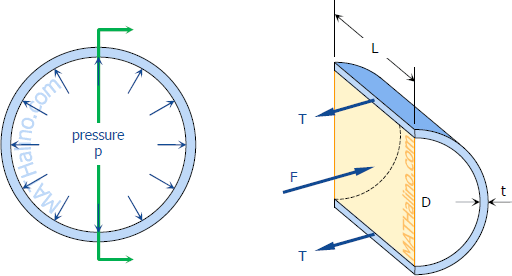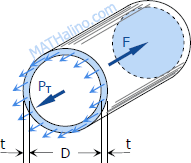Thin-walled Pressure Vessels
A tank or pipe carrying a fluid or gas under a pressure is subjected to tensile forces, which resist bursting, developed across longitudinal and transverse sections.
TANGENTIAL STRESS, σt (Circumferential Stress)
Consider the tank shown being subjected to an internal pressure p. The length of the tank is L and the wall thickness is t. Isolating the right half of the tank:

The forces acting are the total pressures caused by the internal pressure p and the total tension in the walls T.
$F = pA = pDL$
$T = \sigma_t A_{wall} = \sigma_t \, tL$
$\Sigma F_H = 0$
$F = 2T$
$pDL = 2(\sigma_t \, tL)$
If there exist an external pressure po and an internal pressure pi, the formula may be expressed as:
LONGITUDINAL STRESS, σL
Consider the free body diagram in the transverse section of the tank:

The total force acting at the rear of the tank F must equal to the total longitudinal stress on the wall PT = σLAwall. Since t is so small compared to D, the area of the wall is close to πDt
$F = pA = p\dfrac{\pi}{4} D^2$
$P_T = \sigma_L \pi Dt$
$\Sigma F_H = 0$
$P_T = F$
$\sigma_L \, \pi Dt = p\dfrac{\pi}{4} D^2$
If there exist an external pressure po and an internal pressure pi, the formula may be expressed as:
It can be observed that the tangential stress is twice that of the longitudinal stress.
SPHERICAL SHELL

If a spherical tank of diameter D and thickness t contains gas under a pressure of p = pi - po, the stress at the wall can be expressed as:
- Log in to post comments
